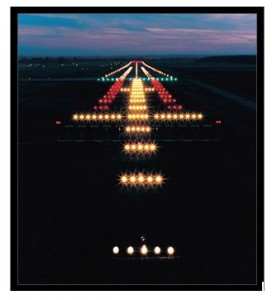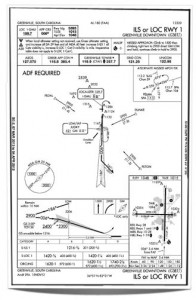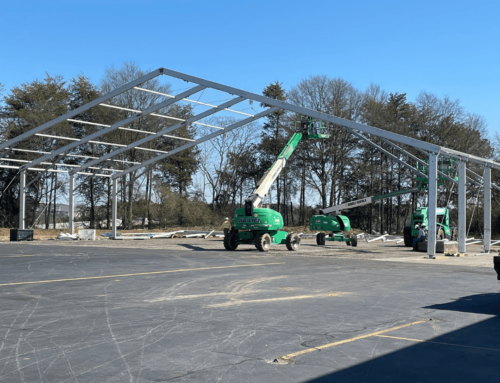By Jarod Spencer
 When do you have to fly the procedure turn and when can you instead proceed straight in? If you ask a fellow pilot or visit an online discussion forum you will find a number of opinions. Furthermore, it is not uncommon for ATC to also be mistaken about straight in vs. full approaches. It is the responsibility of the PIC to maintain compliance with regulations.
When do you have to fly the procedure turn and when can you instead proceed straight in? If you ask a fellow pilot or visit an online discussion forum you will find a number of opinions. Furthermore, it is not uncommon for ATC to also be mistaken about straight in vs. full approaches. It is the responsibility of the PIC to maintain compliance with regulations.
Consider this scenario, you are conducting an approach that depicts a procedure turn. ATC instructs you to proceed direct to a fix on the approach and clears you for the straight in approach. Do you have to fly the procedure turn? Yes. If you answered No, you would be incorrect because ATC actually issued an improper clearance.
FAR 91.175 (j) makes this clear by stating that, “In the case of a radar vector to a final approach course or fix, a timed approach from a holding fix, or an approach for which the procedure specifies “No PT,” no pilot may make a procedure turn unless cleared to do so by ATC.” The inverse of 91.175 (j) means that if you are not being vectored, the approach does not state NoPT, or you are not on a timed approach, you must fly the procedure turn.
To make the effect of 91.175 (j) crystal clear, the FAA Chief Counsel interpretation states that, “…if a SIAP does contain a procedure turn and ATC has cleared a pilot to execute the SIAP, the pilot must make the procedure turn when one of the conditions of Section 91.175(j) is not present”. In other words, because you were cleared direct and not on a vector, you must fly the entire approach. The pilot controller glossary defines radar vectoring as “provision of navigational guidance to aircraft in the form of specific headings, based on the use of radar”. If you were cleared direct, you were not on a heading. Thus, you were not vectored. The end result is that you must fly the procedure turn. ATC may not be expecting your actions so be sure to clarify with ATC.
 If, in fact, you are being vectored by ATC, several conditions must be met to conduct a straight in approach. FAA Order JO 7110.65U instructs ATC as to how to conduct ATC operations. For vectors to the approach, ATC must vector you to intercept the final approach course within 30 degrees (45 degrees for helicopters) and no less
If, in fact, you are being vectored by ATC, several conditions must be met to conduct a straight in approach. FAA Order JO 7110.65U instructs ATC as to how to conduct ATC operations. For vectors to the approach, ATC must vector you to intercept the final approach course within 30 degrees (45 degrees for helicopters) and no less
than 2 miles from the approach gate. The approach gate is defined as “an imaginary point used within ATC as a basis for vectoring aircraft to the final approach course. The gate will be established along the final approach course 1 mile from the final approach fix on the side away from the airport and will be no closer than 5 miles from the landing threshold”. It also states that you must be vectored “for a precision approach, at an altitude not above the glideslope/glidepath or below the minimum glideslope intercept altitude specified on the approach procedure chart or for a non-precision approach, at an altitude which will allow descent in accordance with the published procedure”.
The two exceptions to the 2 mile requirement are when the weather is 500 feet above the MVA/MIA and the visibility is at least 3 miles or if the pilot requests it. Either way, you must be vectored within 20 degrees. If the weather allows, you cannot be allowed to intercept closer than the approach gate. If the pilot requested it, you cannot be allowed to intercept any closer than the final approach fix. Note that you cannot use this exception if you are on a GPS or RNAV approach.
In any case, if confusion exists about ATC instructions, FAR 91.123 (a) states that the “pilot shall immediately request clarification from ATC”. Keep in mind that sometimes ATC is not always aware of the proper interpretation of the rules discussed above.
To revisit the scenario, a correct clearance would say something like “N905LC is 7 miles from JUDKY, turn left heading 030, intercept the ILS 01 localizer, maintain 3,000 feet until established, cleared for ILS runway 01 straight in approach”. Notice that a vector within 30 degrees was given and you are far enough away from the approach gate. As a result you are properly cleared straight in.
Remember that to proceed straight in you must be on vectors, be on a portion of the approach that states NoPT, or be on a timed approach. When flying an approach, it is easy to accept an improperly issued, straight in clearance in an effort to save hassle, time, and money. Since ATC is not always clear about the regulations, you may even get away with it. However, do not let the fact that this particular issue tends to slide through the cracks be an excuse for not following the regulations. It can be unsafe and may lead to a violation.






Leave A Comment